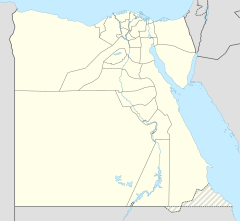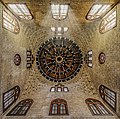Sultan al-Ghuri Complex
| Sultan Qansuh Al-Ghuri Complex | |
|---|---|
 Sultan al-Ghuri's complex, with mausoleum/khanqah (left), and mosque/madrasa (right). | |
| Religion | |
| Affiliation | Islam |
| Ecclesiastical or organizational status | active mosque (western building), tourist attraction and historic site (eastern building) |
| Year consecrated | 1503-1505 |
| Location | |
| Location | |
| Geographic coordinates | 30°2′45.78″N 31°15′35.57″E / 30.0460500°N 31.2598806°E |
| Architecture | |
| Type | mausoleum, khanqah, sabil-kuttab, madrasa |
| Style | Mamluk, Islamic |
| Minaret(s) | 1 |
The Sultan Al-Ghuri Complex or Funerary complex of Sultan al-Ghuri, also known as al-Ghuriya[1], is a monumental Islamic religious and funerary complex built by Sultan Qansuh al-Ghuri between 1503 and 1505 CE. The complex consists of two major buildings facing each other on al-Mu'izz li-Din Allah street (al-Muizz Street), in the Fahhamin Quarter, in the middle of the historic part of Cairo, Egypt. The eastern side of the complex includes the Sultan's mausoleum, a khanqah, a sabil (water distribution kiosk), and a kuttab (Islamic primary school), while the western side of the complex is a mosque and madrasa.[2] Today the mosque-madrasa is still open as a mosque while the khanqah-mausoleum is open to visitors as a historic site.[3]
History

The second last of the Mamluk sultans, Sultan Qansuh al-Ghuri was the last Mamluk sultan to enjoy a reign of any duration (1501–16). He was called 'Al-Ghuri' after the barracks Al-Ghuri, where he was garrisoned.[4] He was the governor of Tarsus, then the chamberlain of Aleppo and he was involved heavily in the military campaign against the Ottomans in 1484. Al-Ghuri died of a heart attack while fighting the Ottoman Turks outside Aleppo, following the defection of Amir Khayrbak in the midst of the battle. His body was never found, and was not buried in his mausoleum on which he had spent a fortune.[2] Like other Sultans of his time, Al-Ghuri is portrayed as energetic, cruel, superstitious and despot leader. Harsh punishments were imposed on people during his reign for crimes committed or during money collection. Despite cruelty, Al-Ghuri had a huge fond of music, poetry and flowers and was attracted to Sufis and other pious men. He was a great patron of architecture, and a man of refined cultural tastes. Although the economic conditions was somewhat miserable, the sultan pursued to the very end of his reign a passion for regal pomp, spending considerable funds and confiscating properties to build representative buildings.[4]
Layout
The funerary complex has a remarkable layout as a double architectural composition, with two blocks straddling the main street in the heart of medieval Cairo. There are two blocks: the western - consisting of a mosque with its minaret; the eastern one is a funerary complex, consisting of a mausoleum, a hall called Khanqah, a maq'ad (reception hall), a graveyard and a sabil-kuttab.[5] Both the buildings are built above shops connected to markets stretching along the side street. To provide shade for the street a wooden roof links the buildings. Although the dome and the minaret are separated by the street, they were conceived as a single, harmonious composition and were united by blue ceramic decoration. These blue ceramics are similar to the blue ceramic decoration other the sultan's minaret at Al-Azhar.[6]
The complex was designed to reveal its minaret-and-dome composition to an onlooker coming from the south. Unlike other religious complexes, the facades of the complex are not adjusted to the street alignment. They rather follow the orientation of the two sides of the complex. This creates a square and is semi-enclosed at the north end by the projection of the sabil-kuttab of the mausoleum, and at the south end by the projection of the minaret of the madrasa. The open space was rented to people to create market stalls. The market and the rents helped pay for the upkeep of al-Ghuri's complex.
Mosque
The facades of the two buildings are not identical, however they have similar features such as the high-relief carving running along their upper walls. The portal recesses have marble paneling in variations of black and white. The columns at the corner of the mosque have capitals of Coptic and Byzantine styles, indicating that the Mamluk craftsmen were imitating pre-Islamic designs.[6] The huge minaret is visible from near Bab Zuwayla, and is a four storied rectangular tower of a considerable height. This tower had a four-headed upper structure and was the first of its kind to be built in Cairo. The present top with five-headed structure is a modern addition after the collapse of the top in the nineteenth century. The interior is richly paved and paneled with black and white marble. However the stone carving covers the walls but it is of poor quality, shallow and repetitive.
Khanqah and mausoleum
The main facade of the funerary compound is paneled with recesses crowned with a rectangular muqarnas crest, including windows of various shapes.[7] The main portal leads to an unusual vestibule with two opposite entrances, the one on the right-hand side leading to the mausoleum and the other to the khanqah. On the northern edge a sabil-kuttab projects into the street with three facades. The mausoleum on the south side of the interior presently has only its rectangular base and transition zone. The dome, made of brick and covered completely with green tiles, collapsed at the beginning of the century.
On the left or north side of the entrance resides the khanqah, though no living units were attached to it. The waqf deed says that Sufis had their meetings there, but there are no living accommodations provided for them. however, there are a few living units attached to the madrasa across the street. The khanqah is a T shaped hall with a mihrab, decorated like the mausoleum and the Mosque with a polychrome marble dado and pavement. Each of the three mihrabs of the complex has a distinct pattern of marble mosaics. The polychrome marble pavement of the sabil, displaying a dense composition of twenty-pointed geometric stars, is one of the most elaborate in Cairo.[8]
Gallery
-
The facade of the khanqah-mausoleum, east side of the street.
-
The sabil-kuttab of the khanqah-mausoleum. The sabil (public water dispensary) is on the first floor while the kuttab (elementary school) is on the second floor.
-
Entrance portal of the khanqah-mausoleum.
-
The wooden dome above the main hall of the khanqah, where Sufi gatherings took place.
-
The drum of the dome above the mausoleum. The original dome was unstable and was replaced with a flat wooden ceiling in the 19th century.
-
Details of the stone-carvings up near the dome, just under the wooden roof.
-
The interior of the madrasa-mosque
-
The main iwan of the prayer hall in the madrasa-mosque.
-
Looking up from the courtyard of the madrasa. A cornice of muqarnas runs along the top edge of the courtyard. Stone-carved arabesque patterns decorate the walls.
-
The northern iwan of the madrasa courtyard.
-
Windows in the madrasa, with elaborate stucco grilles.
-
An example of marble mosaic pavement.
-
The marble mosaic panels and marble inscription band (in Kufic Arabic script) that runs along the courtyard of the madrasa-mosque.
-
The minaret, built above the madrasa-mosque.
-
The staircase inside the minaret.
-
The mausoleum chamber.
-
The dome of the mausoleum chamber (now replaced by a flat wooden roof, but preserving the stone pendentives at its four corners).
See also
- Sultan al-Ashraf Qansuh al-Ghuri
- al-Muizz Street
- Mamluk architecture
- Islamic architecture
- Wikala of Al-Ghuri
- List of mosques in Cairo
- Lists of mosques
- List of mosques in Africa
- List of mosques in Egypt
References
- ^ Williams, Caroline (2018). Islamic Monuments in Cairo: The Practical Guide (7th ed.). Cairo: The American University in Cairo Press. pp. 196–200.
- ^ a b "Archnet". archnet.org.
- ^ Lee, Jessica; Sattin, Anthony (2018). Lonely Planet: Egypt (13th ed.). Lonely Planet. p. 76.
- ^ a b Behrens-Abouseif, Doris. "Cairo of the Mamluks". Cairo:AUC Press, 2008. p 295
- ^ Behrens-Abouseif, Doris. "Cairo of the Mamluks". Cairo:AUC Press, 2008. p 296
- ^ a b Behrens-Abouseif, Doris. "Cairo of the Mamluks". Cairo:AUC Press, 2008. p 297
- ^ Behrens-Abouseif, Doris. "Cairo of the Mamluks". Cairo:AUC Press, 2008. p 300
- ^ Behrens-Abouseif, Doris. "Cairo of the Mamluks". Cairo:AUC Press, 2008. p 302





















